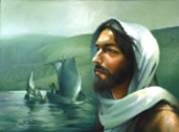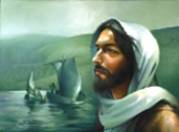After a criminal had been sentenced to the cross, he would be stripped of his clothes and tied to a post in the tribunal. Then, a most cruel and severe form of scourging would begin. The whip, called a "flagrum," was an instrument with many lashes, to which pieces of sharp bone and metal were attached. One expert in pathology describes the torture as such:
"Over an over again the metal tips dug deep into the flesh, ripping small vessels,
nerves, muscles, and skin. The victim writhed, rolled, wrenched and his whole body
became distorted with pain, causing him to fall to the ground, only to be jerked up
again. Seizurelike activities occurred, followed by tremors, vomiting, and cold sweats."
Of this gruesome torture, the early Church historian Eusebius wrote: "The veins were laid bare, and the very muscles, sinews, and bowels of the victim were open to
exposure." According to the Law of Moses, as stipulated in the Book of Deuteronomy, the Israelites limited the number of lashes to forty (Deuteronomy 25:3). (It is important to note that the Israelites never used any whip-like instrument that resembled the Roman flagrum.) But since Jesus was subjected to the Roman system of justice, the limitation of forty lashes did not apply. This excessive pre-crucifixion torture seems to be consistent with the Gospel accounts that seem to imply Pontius Pilate, in hoping to spare Jesus the cross, had Him severely scourged in order that the wrath of the Jewish mob might be quenched by such an awful spectacle of a "
In considering the pre-crucifixion suffering of Jesus, which was, no doubt, more intense that the typical victim, something must be said about the "crown of thorns" that was forced upon the head of Jesus. Many experts agree that the "crown" was made from either the "zizphus spina" or the "Paliuris spina," both members of the buckthorn family with thin, one-inch thorns. Medical experts have commented about the nerves with regard to the area of the scalp. Essentially, any laceration of the small blood vessels would result in severe pain and significant bleeding. Although the physical pain caused by the "crown of thorns" must have certainly been excruciating, the sorrow, grief, and mockery must have caused Jesus even more pain.
After the fateful sentence was pronounced the victim was forced to carry his cross, or usually just the crossbeam (which could weigh a hundred pounds), to the site of execution, which in Jesus' case would have been just outside the walls of Jerusalem, probably along one of the main roads leading into the city. The purpose for exposing crucified victims to passers-by was to fortify the impression of Roman military power in the minds of incoming Jewish pilgrims. And above the infrastructure of the crosses, vultures would be circling, waiting to pick away at the dying carcasses hanging on the Roman crosses. Outside of
Anyway, after the words "Ibis ad crucem" were uttered by the prefect (Roman military governor), the victim would take up his cross (or crossbeam), a herald would sometimes walk ahead of the victim announcing the crime while holding up the placard (i.e. the wooden plate placed above the victim's head on the cross) with the criminal charges written upon it. At other times, the placard would be hung around the victim's neck as he staggered through the streets, all the while being goaded along by the spears of the attending soldiers. The placard placed above Jesus' head on the cross read "King of the Jews."
At the site of execution, the victim would be nailed through the wrists (7 inch spikes) to the crossbeam, and then, drawn up by ropes, the crossbeam would be fastened to the vertical beam. Then, with allowing some flexibility at the knees, the executioner would hammer the third spike through the victim's feet, or sometimes a spike would be hammered through each heel. (There was no uniformity or precise methodology with regard to crucifxion.) Interestingly, some scholars believe that the skeleton of a crucified victim named Yohanan, unearthed in 1967, shows that one long spike was driven through the "heel" bones of his two feet which were crossed over.
The Cause of Death - Pathology
In most crucifixions, the victim was "tied" to the cross, instead of being nailed, and he was allowed to hang there for days. Historical records tell us of instances where some victims survived on the cross for as many as nine days. In these cases, the bodies were left to rot on the cross, while the carrion birds feasted on the dead carcasses. During the imperial persecutions of Christians (ca. 64-312), stories were told of women martyrs who were crucified upside-down, naked, and allowed to hang there until their deaths. Eusebius would comment that this was "the most shameful, brutal, and inhuman of all spectacles to everyone watching."
In the case of Jesus, who was "nailed" to the cross, after incurring the previously described pre-crucifixion torture (i.e. the severe scourging), the death process, though swifter than the use of ropes, was excuciatingly more painful. One author describes it as such:
"The lacerating veins and crushed tendons throbbed with incessant anguish;
the wounds, inflamed by exposure, gradually gangrened; the arteries, especially
at the head and stomach, became swollen and oppressed with surcharged blood;
and while each variety of misery went on gradually increasing, there was added
to them the intolerable pang of a burning and raging thirst."
Accompanying the overwhelming pain was an extreme complication in the normal respiratory function. One expert pathologist, in researching the medical cause of Jesus' death, temporarily suspended himself upon a model cross, and subsequently stated: "The deltoid (shoulder) and pectoral (chest) muscles promptly assume a state of spasm, and the victim so suspended is physically unable to make use of this thoracic (upper body) muscles of respiration." In order for the victim to breathe, he had to push himself up by his feet, which were nailed to the vertical beam, thus taking advantage of the flexibility allotted to him by the executioner. However, the pressure on his feet became unbearable, and he would once again collapse into the hanging position, thus putting an intolerable tearing pressure on the affixed hands (wrists). Also, the intense pain caused by the scourging would become aggravated during this "up and down" motion, due to the frictional contact between the victim's back and vertical beam.
After the victim had endured for several hours on the cross (from the Gospel records we can deduce that Jesus hung on the cross for at least six hours), the Roman soldiers, in order to hasten the death process, would smash the lower leg bones; an action called "crucifragium." Crucifragium made it impossible for the victim to move "up and down," thereby affixing the victim in the collapsed position and inducing death through repiratory malfunction. Interestingly, the skeleton of Yohanan reveals that the legs were shattered by one powerful blow.
Of course the Gospels tell us that crucifragium was not necessary in Jesus' case because He was already dead. This was in fulfillment of the prophecy that not one of His bones would be broken (Psalm 34:20). However, the Scriptures also tell us that one of the soldiers pierced His side with a spear (not an unusual practice) to certify in fact that He was truly dead. One expert points out: "If Jesus had been alive after the spear wound, the soldiers as well as others at the site would have heard a loud sucking sound caused by breath being inhaled past the chest wound."
Modern medical pathology has concluded, therefore, after a careful and intense examination of the facts, that the cause of Jesus' death was "cardiac and respiratory arrest due to cardiogenic, traumatic, and hypovolemic shock due to crucifixion." Indeed, these conclusions were affirmed in an intense study by the prestigious "Journal of the American Medical Association." Perhaps the best depiction of Jesus' suffering and death on the cross was best described by the Shroud expert, Frederick Zugibe:
"He was almost totally exhausted and in severe pain. Sweat poured over his
entire body, drenching him. . . The burning, excruciating pains from the nails, the irritation by the crown of thorns, the burning wounds from the scourging, the severe pull on the shoulders, the intense cramps in the knees, and the severe thirst together composed a symphony of unrelenting pain.
Then he lifted his head up to heaven and cried out in a loud voice,
'It is finished.' Jesus was dead."
A Procedural and Pathological Approach
by William J. Tsamis
http://www.philosophy-theology.net/crucifixion.htm
Accessed
By B. D. Phillips



